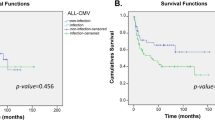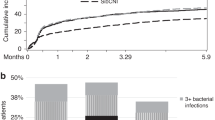Abstract
A growing body of evidence indicates that genetic factors are involved in an increased risk of infection. We investigated whether mannose-binding lectin (MBL) gene polymorphisms that cause low levels of MBL are associated with the occurrence of major infections in patients, mainly bearing hematological malignancies, after high-dose chemotherapy (HDT) rescued by autologous peripheral blood stem cell transplantation (auto-PBSCT). A retrospective evaluation of 113 patients treated with HDT and auto-PBSCT revealed that the low-producing genotypes, B/B and B/LXA, were associated with major bacterial infection (P=0.0016, OR 7.9). We next performed a nation-wide large-scale study to assess the allele frequency of the MBL coding mutation in a total of 2623 healthy individuals in Japan. The frequency of allele B was estimated to be ∼0.2, almost the same in seven different areas of Japan. This common occurrence suggests that MBL deficiency may play an important role in the clinical settings of immunosuppression.
This is a preview of subscription content, access via your institution
Access options
Subscribe to this journal
Receive 6 digital issues and online access to articles
$119.00 per year
only $19.83 per issue
Buy this article
- Purchase on Springer Link
- Instant access to full article PDF
Prices may be subject to local taxes which are calculated during checkout

Similar content being viewed by others
References
Turner MW . Mannose-binding lectin (MBL): the pluripotent molecule of the innate immune system. Immunol Today 1996; 17: 532–540.
Matsushita M . The lectin pathway of the complement system. Microbiol Immunol 1996; 40: 887–893.
Ghiran I, Barbashov SF, Klickstein LB, Tas SW, Jensenius JC, Nicholson-Weller A . Complement receptor 1/CD35 is a receptor for mannan-binding lectin. J Exp Med 2000; 192: 1797–1807.
Turner MW . Mannose-binding lectin (MBL) in health and disease. Immunobiology 1998; 199: 327–339.
Madson HO, Garred P, Thiel S et al. Interplay between promoter and structural gene variants control basal serum level of mannan-binding protein. J Immunol 1995; 155: 3013–3020.
Aittoniemi J, Miettinen A, Laippala P et al. Age-dependent variation in the serum concentration of mannan-binding protein. Acta Paediatr 1996; 85: 906–909.
Holmskov U, Thiel S, Jensenius JC . Collectins and ficolins: humoral lectins of the innate immune defense. Ann Rev Immunol 2003; 21: 547–548.
Super M, Thiel S, Lu J, Levinsky RJ, Turner MW . Association of low levels of mannan-binding protein with a common defect of opsonisation. Lancet 1989; II: 1236–1239.
Summerfield JA, Sumiya M, Levin M, Turner MW . Association of mutations in mannose binding protein gene with childhood infection in consecutive hospital series. BMJ 1997; 314: 1229–1232.
Garred P, Madsen HO, Halberg P et al. Mannose-binding lectin polymorphisms and susceptibility to infection in systemic lupus erythematosus. Arthritis Rheum 1999; 42: 2145–2152.
Garred P, Pressler T, Madsen MO et al. Association of mannose-binding lectin gene heterogeneity with severity of lung disease and survival in cystic fibrosis. J Clin Invest 1999; 104: 431–437.
Gabolde M, Guilloud-Bataille M, Feingold J, Besmond C . Association of variant alleles of mannose binding lectin with severity of pulmonary disease in cystic fibrosis: cohort study. BMJ 1999: 1166–1167.
Neth O, Hann I, Turner MW, Klein NJ . Deficiency of mannose-binding lectin and burden of infection in children with malignancy: a prospective study. Lancet 2001; 358: 614–618.
Peterslund NA, Koch C, Jensenius JC, Thiel S . Association between deficiency of mannose-binding lectin and severe infections after chemotherapy. Lancet 2001; 358: 637–638.
Mullighan CG, Heatley S, Doherty K et al. Mannose-binding lectin gene polymorphisms are associated with major infection following allogeneic hemopoietic stem cell transplantation. Blood 2002; 99: 3524–3529.
Rocha V, Franco RF, Porcher R et al. Host defense and inflammatory gene polymorphisms are associated with outcomes after HLA-identical sibling bone marrow transplantation. Blood 2002; 100: 3908–3918.
Kilpatrick DC, McLintock LA, Allan EK et al. No strong relationship between mannan binding lectin or plasma ficolons and chemotherapy-related infections. Clin Exp Immunol 2003; 134: 279–284.
Morita C, Horiuchi T, Tsukamoto H et al. Association of tumor necrosis factor receptor type II polymorphism 196R with systemic lupus erythematosus in the Japanese. Molecular and functional analysis. Arthritis Rheum 2001; 44: 2819–2827.
Kilpatrick DC . Mannan-binding lectin: clinical significance and applications. Biochim Biophys Acta 2002; 1572: 401–413.
Horiuchi T, Tsukamoto H, Morita C et al. Mannose-binding lectin (MBL) gene mutation is not a risk factor for systemic lupus erythematosus (SLE) and rheumatoid arthritis (RA) in Japanese. Genes Immun 2000; 1: 464–466.
Shi L, Takahashi K, Dundee J et al. Mannose-binding lectin-deficient mice are susceptible to infection with Staphylococcus aureus. J Exp Med 2004; 199: 1379–1390.
Harada M . Allogeneic peripheral blood stem cell transplantation as an alternative to allogeneic bone marrow transplantation. Intern Med 1998; 37: 1001–1002.
Siena S, Bregni M, Brando B et al. Flow cytometry for clinical estimation of circulating hematopoietic progenitors for autologous transplantation in cancer patients. Blood 1991; 77: 400–409.
To LB, Roberts MM, Haylock DN et al. Comparison of haematological recovery times and supportive care requirements of autologous recovery phase peripheral blood stem cell transplants, autologous bone marrow transplant, and allogeneic bone marrow transplant. Bone Marrow Transplant 1992; 9: 277–284.
Fujii K, Aoyama M, Shinagawa K et al. Risk of neutropenic fever and early complication after autologous peripheral blood stem cell transplantation for malignant diseases. Int J Hematol 2002; 76: 186–191.
Van Burik JA, Weisdorf DJ . Infections in recipients of blood and marrow transplantation. Hematol Oncol Clin N Am 1999; 13: 1065–1089.
Bergmann OJ, Christiansen M, Laursen I et al. Low levels of mannose-binding lectin do not affect occurrence of severe infections or duration of fever in acute myeloid leukemia during remission induction therapy. Eur J Haematol 2003; 70: 91–97.
Sasaki T, Tahira T, Suzuki A et al. Precise estimation of allele frequencies of single-nucleotide polymorphisms by a quantitative SSCP analysis of pooled DNA. Am J Hum Genet 2001; 68: 214–218.
Tsutsumi A, Sasaki K, Wakamiya N et al. Mannose-binding lectin gene: polymorphisms in Japanese patients with systemic lupus erythematosus, rheumatoid arthritis and Sjogren's syndrome. Genes Immun 2001; 2: 99–104.
Valdimarsson H, Vikingdottir T, Bang P et al. Human plasma-derived mannose-binding lectin: a phase I safety and pharmacokinetic study. Scand J Immunol 2004; 59: 97–102.
Valdimarsson H, Stefansson M, Vikingdottir T et al. Reconstitution of opsonizing activity by infusion of mannan-binding lectin (MBL) to MBL deficient humans. Scand J Immunol 1998; 48: 116–123.
Author information
Authors and Affiliations
Corresponding author
Rights and permissions
About this article
Cite this article
Horiuchi, T., Gondo, H., Miyagawa, H. et al. Association of MBL gene polymorphisms with major bacterial infection in patients treated with high-dose chemotherapy and autologous PBSCT. Genes Immun 6, 162–166 (2005). https://doi.org/10.1038/sj.gene.6364165
Received:
Revised:
Accepted:
Published:
Issue Date:
DOI: https://doi.org/10.1038/sj.gene.6364165
Keywords
This article is cited by
-
Low pre-transplant levels of mannose-binding lectin are associated with viral infections and mortality after haematopoietic allogeneic stem cell transplantation
BMC Immunology (2019)
-
Low circulating mannan-binding lectin levels correlate with increased frequency and severity of febrile episodes in myeloma patients who undergo ASCT and do not receive antibiotic prophylaxis
Bone Marrow Transplantation (2017)
-
The role of mannose binding lectin on fever episodes in pediatric oncology patients
Pathology & Oncology Research (2016)
-
Mannose-binding lectin gene variants and infections in patients receiving autologous stem cell transplantation
BMC Immunology (2014)
-
Antimicrobial therapy of febrile complications after high-dose chemotherapy and autologous hematopoietic stem cell transplantation—guidelines of the Infectious Diseases Working Party (AGIHO) of the German Society of Hematology and Oncology (DGHO)
Annals of Hematology (2012)



